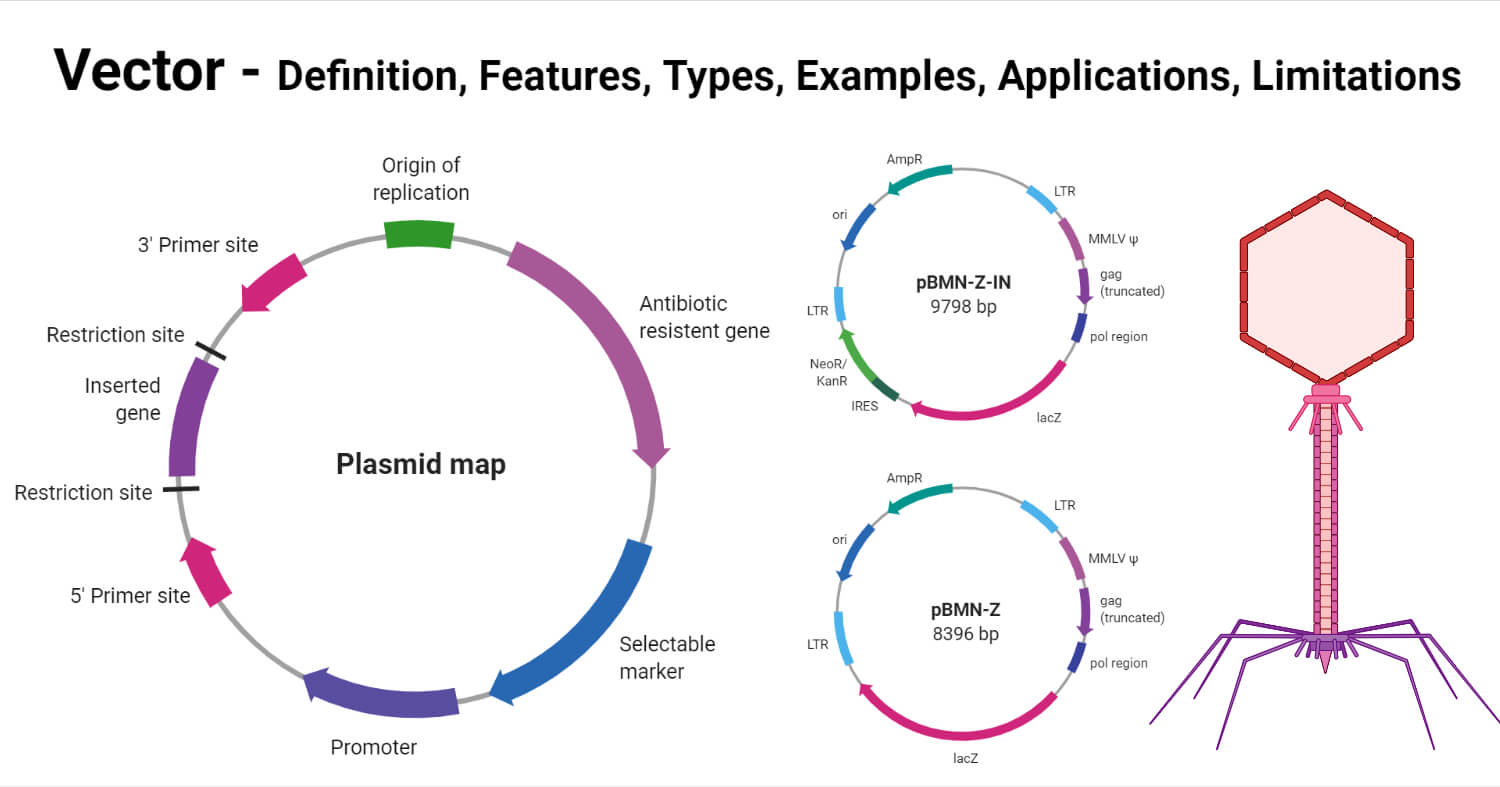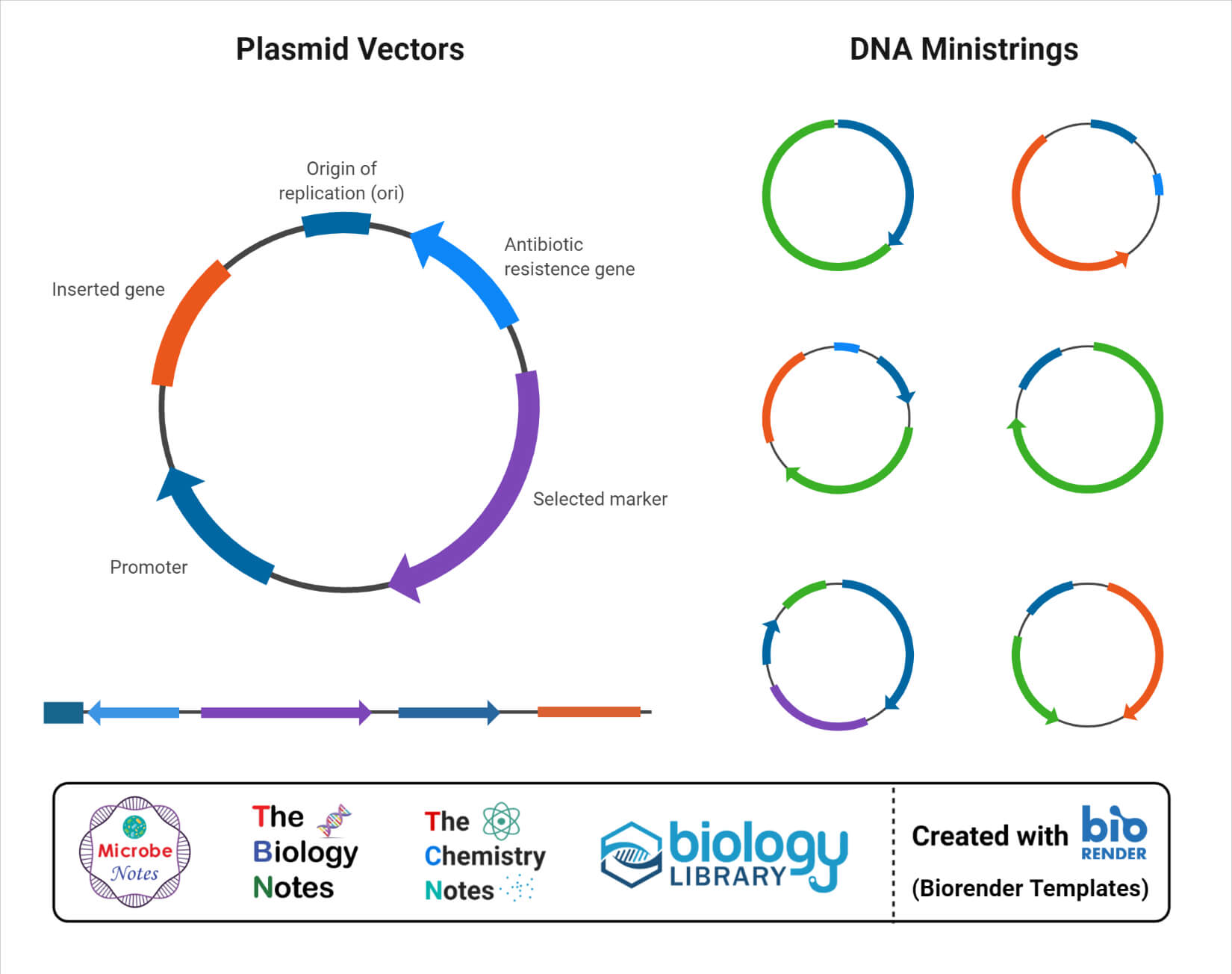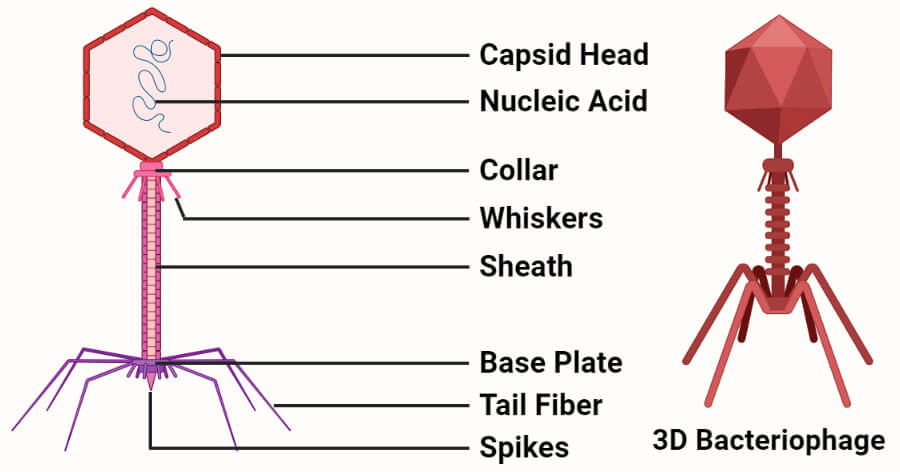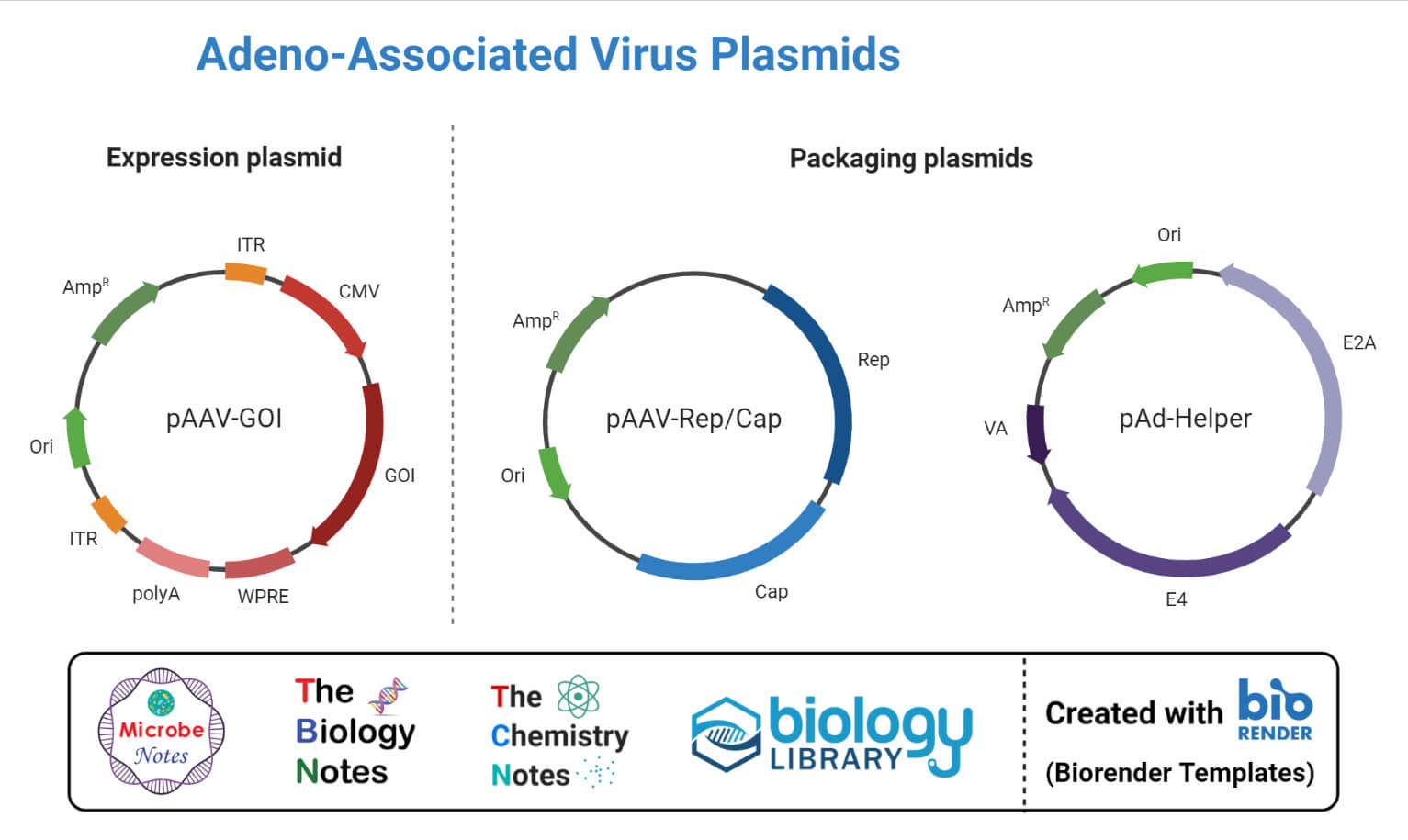Vector Definition
A vector is a substance, usually a piece of DNA that carries a sequence of DNA or other genetic material and introduces it into a new cell.
- Vectors act as vehicles to transfer genetic material from one cell to the other for different purposes like multiplying, expressing, or isolation.
- Vectors are used as a tool in molecular cloning procedures so as to introduce the desired DNA insert into a host cell.
- The DNA insert that is transmitted by a vector is termed recombinant DNA, and the process is also known as recombinant DNA technology.
- Usually, the vectors are DNA sequences that carry different parts involved in different functions. Vectors usually have an insert, also known as a transgene, that carries the recombinant DNA and a larger sequence called the backbone of the vector responsible for the structure of the vector.
- Vectors can be classified into different types depending on different characteristics. The selection of vectors thus depends on the purpose of the process.
- Vectors are an important component of the genetic engineering process as these form the basis for the transfer of DNA fragments from one cell to another.
- Vectors have particular features that carry the gene sequences and enable them to survive within the host cell.
- The process of gene transfer also differs in different vectors where some enter the host cell and get incorporated into the host DNA, whereas the others just pass the genetic material into the host cell and recover themselves.
- Even though vectors are usually DNA sequences, viruses and other particles can also function as vectors in processes like transduction.
- Vectors can be reused for multiple processes as these can be recovered at the end of the process.
- A cloning vector is a category of vectors that are essential for cloning procedures. These vectors have different sequences that enable them to initiate replication in host cells as well as propagate within the host.

Characteristics or Features of vectors
The following are some of the characteristic features of vectors;
- Vectors should be capable of replicating autonomously, which, in turn, depends on the presence of particular sequences in the vector that enables them to initiate replication and propagation within the host cell. Some vectors might even have sequences that allow the production of proteins essential for the inserted DNA, regulation of the process, and further transfer of the insert between different vectors.
- The size of an ideal vector should also be small enough for it to be incorporated into the host genome. The small size of the vector also enables it to incorporate a large-sized insert for transfer.
- Vectors should be easy to isolate and purify as these need to be recovered and reused for multiple processes.
- For a vector to be effective, these should also have certain components that facilitate the process of determining whether the host cell has received the vector. Most vectors used in this process have a gene that either provides resistance to an antibiotic or produces a particular type of protein. These components are called marker genes.
- Many vectors also require unique restriction enzyme recognition sites that enable the insertion of the vector DNA in the presence of specific restriction enzymes. However, many vectors have been designed with a series of restriction sites close to multiple cloning sites that increases the possible restriction enzymes that can be used to digest the sequence.
- The introduction of vectors into the host cell should be easy, which depends on a number of factors.
- In the case of gene transfer processes, it is important that the vector is capable of integrating itself or the recombinant DNA into the genome of the host cell.
- It is important that the introduction of recombinant DNA into the vector doesn’t affect the replication cycle of the vector.
Types of vectors
Vectors can be classified into different groups depending on the purpose of the process and the type of particles used in the process. The following are the commonly studied group of vectors that are used for different purposes;
1. Cloning vectors
- Cloning vectors are vectors that are capable of replicating autonomously and thus are used for the replication of the recombinant DNA within the host cell.
- Cloning vectors are responsible for the determination of which host cells are appropriate for replicating a particular DNA segment.
- Cloning vectors are of further different types that are defined by different features unique to each type of vector.

a. Plasmid vector
- Plasmids are small extrachromosomal circular DNA molecules capable of replicating autonomously within the host cell.
- These are also termed as the workhorse cloning vector in recombinant DNA technology.
- Plasmids are widely used as vectors in all three domains of life; however, these are frequently used in bacteria and yeasts.
- The most important feature of plasmids that makes them one of the best vectors is their small size. The small size of the plasmid facilitates the separation of recombinant DNA from the host’s genomic DNA.
- The size of plasmids ranges from a few thousand base pairs to more than 100 kilobases. The small size of the vector does, however, affect the maximum size of the insert DNA it can carry.
- Plasmids can carry insert DNA that is less than 20 kb as the cloning efficiency and plasmid stability decrease with the size of the vectors.
- The autonomous replication of plasmid is made possible by the presence of genes and sequences that can initiate plasmid replication independent of the host’s replication cycle.
- Bacterial plasmids contain ori sequences that not only control plasmid replication but also determine the possibility of two plasmids coexisting within the same host cell.
- Different plasmids have different types of selective markers, but the most common markers include antibiotic resistance and the production of the β-galactosidase enzyme.
- Some of the most widely used plasmids are pBR322, pUC, and pBluescript vectors that use E. coli as the host.
b. Cosmid
- Cosmid vectors are hybrid vectors composed of plasmid and phage λ vectors, capable of incorporating up to 42 kb of DNA.
- Cosmid vectors are prepared by the insertion of the cos region of the phage vector into the plasmid vectors.
- Cosmid vectors are large-sized vectors with sizes ranging from 400 base pairs to 30 kb. These can carry DNA sequences having sizes ranging from 28 to 46 kb.
- Cosmid vectors are created in order to incorporate large-sized DNA molecules that cannot be carried by plasmids.
- Since these are hybrid vectors, these can replicate within the host cell like plasmids or remain packaged like a phage.
- Cosmid vectors do not have many phage characteristics except the signal sequences that promote phage-head stuffing.
- The hybrid structure of cosmid enables the phage heads to be incorporated within all donor DNA for transfer.
- The use and production of cosmid vectors have increased over the years as the packaged system is highly efficient and selective for the recovery of larger hybrids.
- One of the examples of the cosmid vectors prepared and used in practice are cosmid pHC79 which is a cos-containing derivative of the vector pBR322.
c. Bacteriophage vector

- Bacteriophage vectors are viruses that only infect bacteria and transform them efficiently while carrying large inserts.
- Bacteriophages or phages have higher transformation efficiencies which increase the chances of recovering a clone containing the recombinant DNA segments.
- The most important feature of a phage is the packaging system which enables the incorporation of large eukaryotic genes and their regulatory elements.
- The use of phages also facilitates the isolation of larger quantities of DNA that can be used for the analysis of the insert.
- Even though there are a number of phages that can and have been used as vectors, phage λ is the most convenient cloning vector.
- It can selectively package a chromosome about 50 kb in length, and the size of the phage can be adjusted by removing the central part of the genome as it is not necessary for replication or the packaging of the donor DNA.
- The use of a bacteriophage vector that can incorporate larger DNA segments decreases the number of clones required to obtain a particular DNA library with the entire genome of the organism.
- Phage vectors are also effective as cloning vectors as the recombinant molecules formed after the cloning process are packaged into infective particles that can then be stored or handle efficiently.
- Some of the common phages used as vectors include M13 phages, λ phages, and P1 phages.
d. Bacterial artificial chromosome
- Bacterial artificial chromosomes are engineered DNA molecules that are used to clone DNA segments in bacteria cells (usually E. coli).
- These consist of a bacteria-derived F-factor replication origin which enables the propagation of large DNA fragments in a supercoiled circular form.
- Bacterial artificial chromosomes can carry a much larger size of insert DNA as compared to plasmid or phage vectors.
- These vectors are considered superior over other artificial chromosomes like yeast artificial chromosomes, and mammalian artificial chromosomes as the F-factor found in the bacteria reduces insert chimerism and instability that might arise during the process.
- These are highly efficient as DNA segments as large as 300,000 base pairs can be inserted into bacterial artificial chromosomes, which decreases the number of clones and cycles to be performed to obtain the desired result.
- BAC libraries have been used to generate large genomic DNA inserts for processes like positional cloning, physical mapping, and genome sequencing.
- BAC cloning system has been increasingly used in genetic engineering due to its stability and ease of use as compared to other similar vectors.
- However, BACs have been associated with the random insertion of DNA fragments into the host genome resulting in unpredicted expression.
e. Yeast artificial chromosome
- Yeast artificial chromosomes are engineered DNA molecules that are used to clone DNA inserts within the yeast cells, particularly Saccharomyces cerevisiae.
- YACs have been developed in order to clone large sequences of DNA so as to increase the efficiency of the process.
- YACs can clone up to 500 kb of DNA, which is much higher than most traditional cloning vectors.
- Even though these are frequently used as cloning vectors, they are also helpful in other genetic processes like DNA sequencing and analysis.
- These are also unique in their ability to clone the complete sequences of larger genomes that exceed the limits of traditional techniques.
- Since yeast cells are eukaryotic cells, YACs can be used for unstable sequences when cloned in prokaryotic systems.
- These consist of a mixture of functional units from different organisms, but once the insert DNA is cloned, these can function as normally replicating yeast chromosomes.
- There are some limitations with using YAC as vectors as these introduce a high degree of chimerism and insert rearrangement.
- Since these are eukaryotic cells, these are difficult to handle and have lower efficiencies as compared to bacterial artificial chromosomes.
- Different yeast artificial chromosomes have been created over the years that are then used for different purposes.
- One of the most commonly used examples of yeast artificial chromosomes includes pYAC4, which has been extensively used as a cloning vector.
f. Human artificial chromosome
- Human artificial chromosomes are extrachromosomal DNA fragments that act as a new chromosome within the human cell.
- The use of human artificial chromosomes has increased with advances in genetic engineering as it helps overcome problems commonly associated with traditional vector systems.
- HACs can exist as single copy episomes without integration into the host chromosomes allowing long-term stable maintenance.
- Besides, there is no upper limit in the size of the DNA insert to be incorporated into a HAC as entire genomic units can be used to mimic the natural gene expression.
- In spite of numerous advantages, HACs have only been used for studies related to the structure and function of human kinetochores.
- Limitations associated with HACs are due to technical difficulties during gene loading and ill-defined structures of the vectors.
2. Viral vectors
- Viral vectors are one of the most effective means of gene transfer to modify host cells or tissues and manipulate them to express different types of genes.
- The concept of using viruses as vectors arose from the fact that viruses are very effective in transducing their own genetic information into the host cell.
- During viral transduction, the non-essential viral genes are replaced with foreign DNA sequences of therapeutic interest in order to produce recombinant viral vectors.
- Currently, different groups of viruses have been studied doe their possible use as viral vectors to deliver genes to provide transient or permanent transgene expression.
- The use of viral vectors also enables location specificity with unique injection technology within a specific time period.
- Some of the common virus groups considered for viral vectors are adenoviruses, retroviruses, poxviruses, and adeno-associated viruses.
- The choice of a particular virus as a vector depends on a number of factors that include efficiency of transgenic expression, ease of production, safety, and stability.
- Different clinical trials have been held with different potential viral vectors that are suitable for different purposes.
- Adenoviruses have been used for the transfer of tumor suppressor genes in cancer treatment, and retroviruses are studied for their potential use in tissue repair and engineering.








0 Comments